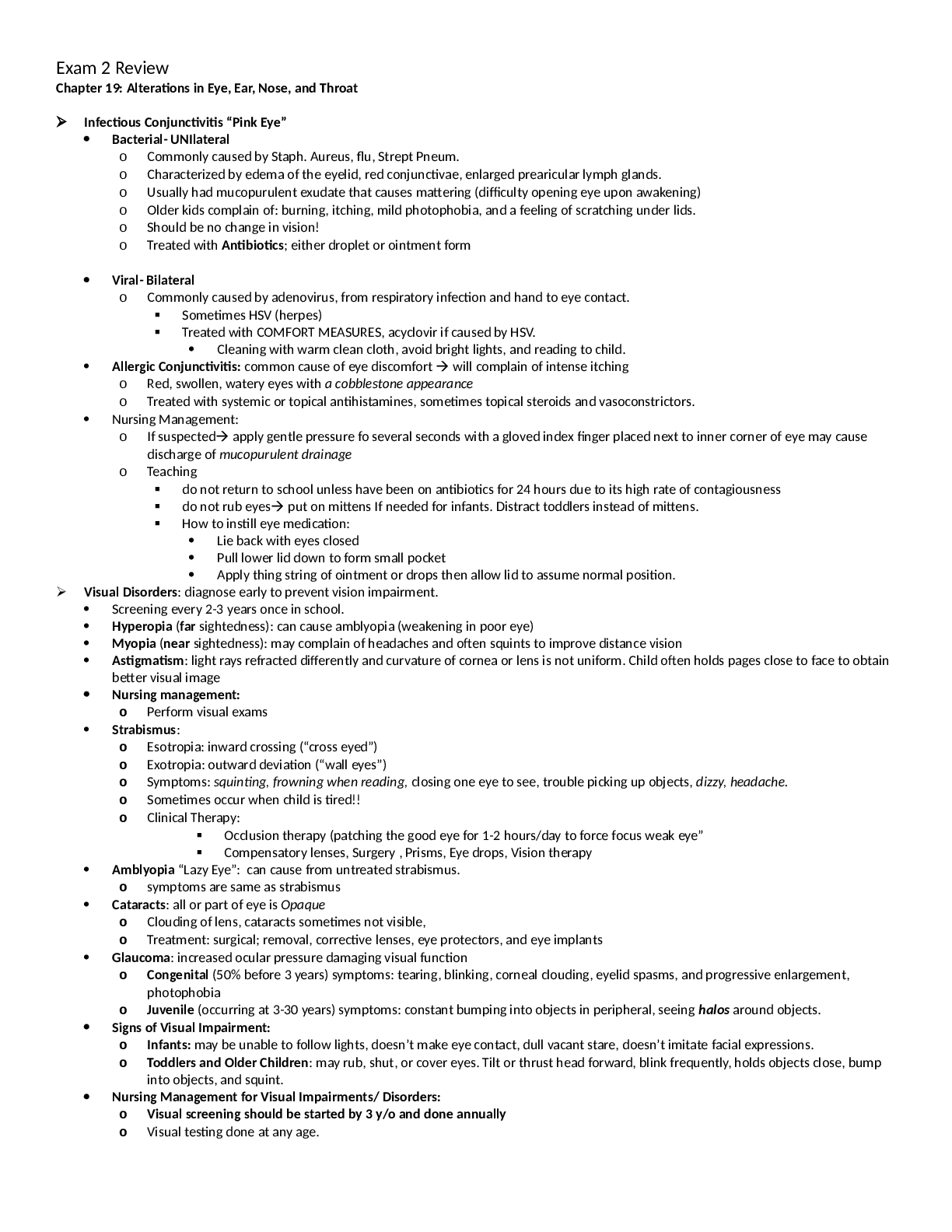Infectious
Visual
Conjunctivitis “Pink Eye”
Bacterial- UNIlateral
o Commonly caused by Staph. Aureus, flu, Strept Pneum.
o Characterized by edema of the eyelid, red conjunctivae, enlarged prearicular lymph glands.
o Usually had mucopurulent exudate that causes mattering (difficulty opening eye upon awakening)
o Older kids complain of: burning, itching, mild photophobia, and a feeling of scratching under lids.
o Should be no change in vision!
o Treated with Antibiotics; either droplet or ointment form
Viral- Bilateral
o Commonly caused by adenovirus, from respiratory infection and hand to eye contact.
Sometimes HSV (herpes)
Treated with COMFORT MEASURES, acyclovir if caused by HSV.
Cleaning with warm clean cloth, avoid bright lights, and reading to child.
Allergic Conjunctivitis: common cause of eye discomfort will complain of intense itching
o Red, swollen, watery eyes with a cobblestone appearance
o Treated with systemic or topical antihistamines, sometimes topical steroids and vasoconstrictors.
Nursing Management:
o If suspected apply gentle pressure fo several seconds with a gloved index finger placed next to inner corner of eye may cause
discharge of mucopurulent drainage
o Teaching
do not return to school unless have been on antibiotics for 24 hours due to its high rate of contagiousness
do not rub eyes put on mittens If needed for infants. Distract toddlers instead of mittens.
How to instill eye medication:
Lie back with eyes closed
Pull lower lid down to form small pocket
Apply thing string of ointment or drops then allow lid to assume normal position.
Disorders: diagnose early to prevent vision impairment.
Screening every 2-3 years once in school.
Hyperopia (far sightedness): can cause amblyopia (weakening in poor eye)
Myopia (near sightedness): may complain of headaches and often squints to improve distance vision
Astigmatism: light rays refracted differently and curvature of cornea or lens is not uniform. Child often holds pages close to face to obtain
better visual image
Nursing management:
o Perform visual exams
Strabismus:
o Esotropia: inward crossing (“cross eyed”)
o Exotropia: outward deviation (“wall eyes”)
o Symptoms: squinting, frowning when reading, closing one eye to see, trouble picking up objects, dizzy, headache.
o Sometimes occur when child is tired!!
o Clinical Therapy:
Occlusion therapy (patching the good eye for 1-2 hours/day to force focus weak eye”
Compensatory lenses, Surgery , Prisms, Eye drops, Vision therapy
Amblyopia “Lazy Eye”: can cause from untreated strabismus.
o symptoms are same as strabismus
Cataracts: all or part of eye is Opaque
o Clouding of lens, cataracts sometimes not visible,
o Treatment: surgical; removal, corrective lenses, eye protectors, and eye implants
Glaucoma: increased ocular pressure damaging visual function
o Congenital (50% before 3 years) symptoms: tearing, blinking, corneal clouding, eyelid spasms, and progressive enlargement,
photophobia
o Juvenile (occurring at 3-30 years) symptoms: constant bumping into objects in peripheral, seeing halos around objects.
Signs of Visual Impairment:
o Infants: may be unable to follow lights, doesn’t make eye contact, dull vacant stare, doesn’t imitate facial expressions.
o Toddlers and Older Children: may rub, shut, or cover eyes. Tilt or thrust head forward, blink frequently, holds objects close, bump
into objects, and squint.
Nursing Management for Visual Impairments/ Disorders:
o Visual screening should be started by 3 y/o and done annually
o Visual testing done at any age.
Read More


